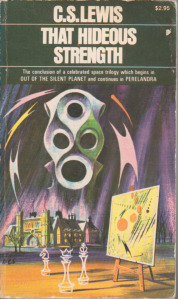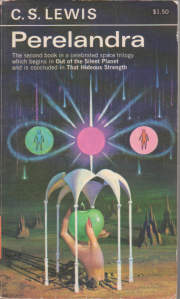The Book: That Hideous Strength: A Modern Fairy-Tale for Grown-Ups by C.S. Lewis. Originally published in 1945, the edition read was published by MacMillan after 1965.
The Setting: England, more or less after WWII
The Story: A husband and wife find themselves on opposite sides of a show down between the forces of good and evil. Featuring: Tame bears, talking heads, bureaucracy, Merlin, and an institute. It’s complicated. Short version: Man and wife aren’t all that in love. Man wants to be in circles of power, wife wants… something else. He pursues new job at the Institute. She has… bad dreams. He gets embroiled at the Institute (it’s evil, by the way) and she wanders over to Camelot where Ransom from the previous books is the Pendragon. Both get deeper at their places, then it all explodes, and they are re-united happily. Not as boring as I made it sound. I swear.
The Science: The Institute has taken a decapitated head, stuck it in a tank with some tubes, and made it live again! It’s like a Frankenstein’s monster, but with less tedious mucking about in the graveyard. Fortunately, such a thing should be impossible. Sure, you could pump blood and air into a dead head, but the brain is really all about the synapses and the neat little electrochemical signals running around in there. And those? Those end when you die. And there’s no bringing ’em back. Not for 10 more years, anyway. It doesn’t really work out for the Institute anyway.
Besides, this book mostly deals with straight up magic. Not so much with the science.
The Reaction: Man, I had a hard time getting into this book. Whether it was because of summer being glorious or the flashbacks to meetings I’ve sat in or the references to a woman being obedient to her husband, it took a while to get rolling. By the final third of the book, I was getting into it, but it all came to a head so quickly that I didn’t really feel satisfied. I mean, it’s a fine story and a very nice book, but I enjoyed the first two books far more.
The Cover: No credit for the cover, but it’s signed BES. The cover is a grab bag of literal things from the book and representations of others. Like the building. That’s in there. And the chess pieces are more about the action in the book. The hole face thing with the spinny colors? I don’t know what that’s about. To lend an air of the supernatural/extraterrestrial, I guess. The cover is ridiculous.
Next Up: “Chrysalis” by Ray Bradbury.



